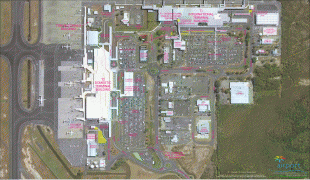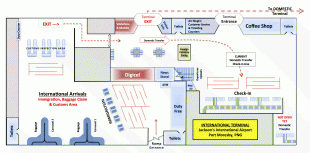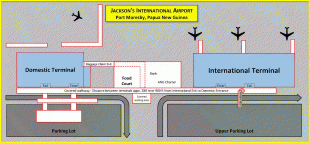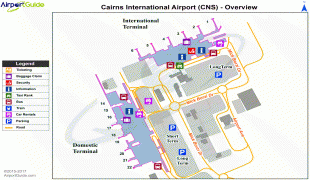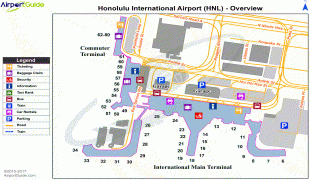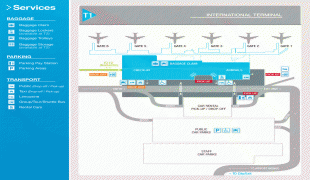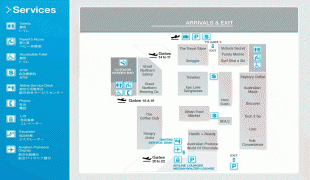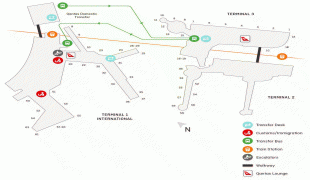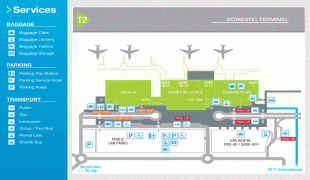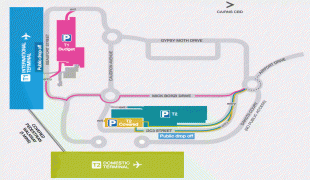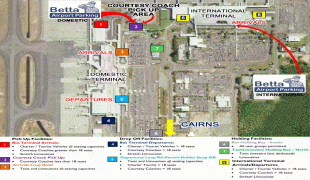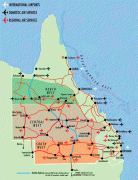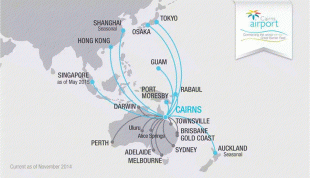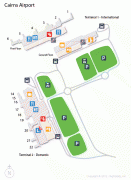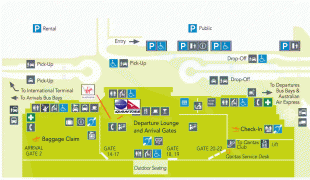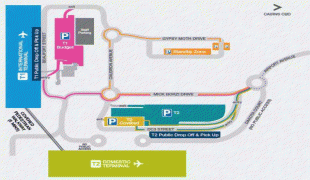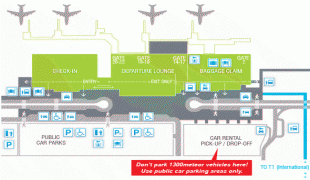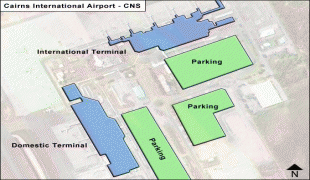Cairns Airport (Cairns International Airport)
Cairns Airport is an international airport in Cairns, Queensland, Australia. Formerly operated by the Cairns Port Authority, the airport was sold by the Queensland Government in December 2008 to a private consortium. It is the seventh busiest airport in Australia. The airport is located 2.3 NM north northwest of Cairns or 7 km north of the Cairns central business district, in the suburb of Aeroglen. The airport lies between Mount Whitfield to the west and Trinity Bay to the east.
The airport has direct flights to 10 international and 35 domestic destinations and many general aviation flights including a number of helicopter operators. Flights are operated to all major Australian cities and tourist destinations, regional communities in Far North Queensland, and a number of international destinations in the Asia-Pacific region with connections to the rest of the world. The airport formed the main base for Australian Airlines prior to its ceasing of operations in June 2006 (the airport remains a major port for parent company Qantas). It is also a base for the Royal Flying Doctor Service of Australia and the search and rescue helicopters of the Queensland Government. In the 12 months ending 30 June 2019 Cairns Airport had just over 5 million passengers.
Cairns Airport goes back to 1928 when Tom McDonald started flying his de Havilland Gipsy Moth off a sand ridge near the present airport. He could only land and take off between high tides. During one emergency, Tom was forced to take off from beer barrels.
During World War II the Australian Government bought the airport for use by the Royal Australian Air Force. In 1943, the main runway was hard surfaced and lengthened to handle military aircraft. It was also used by the United States Army Air Forces as a transport base, with the 33d Troop Carrier Squadron (374th Troop Carrier Group) operating from the base during 1942. In 1949, the main runway was lengthened to 1730 m to accommodate larger aircraft. During the mid-1960s, the airport was upgraded and the runway further lengthened to 2020 m and strengthened so jets could land.
During the 1970s, Australia's two domestic airlines Trans Australia Airlines and Ansett provided regular scheduled services to most Australian capital cities and also Papua New Guinea, while in 1975 Air Niugini became the first international airline to commence flights out of Cairns, to Port Moresby in Papua New Guinea. In 1982, redevelopment of the airport commenced. This involved further lengthening of the runway to 2600 m (making it the longest runway in Queensland) and construction of a new terminal building. The first stage of the redevelopment was finished in 1984 and a dual International and Domestic Terminal was opened. At the end of the decade the second stage of redevelopment was completed. This included a new separate International Terminal, associated aprons and taxiways, costing an estimated $80 million. The main runway was again extended, to 3196 m. In 1997, the third stage of redevelopment was completed, during which a three-storey Airport Administration Centre was constructed providing 4000 m2 of office space.
A$200 million redevelopment of the Domestic terminal started in August 2007 and was completed in 2010. Check-in facilities were expanded into a common-user facility for all airlines, and the building enlarged. Five new jet bridges replaced the existing three old bridges. In January 2010, Auckland International Airport Limited announced that it had purchased 24.6 per cent of North Queensland Airports (NQA), operator of the airports at Cairns and Mackay, for about $132 million.
A further upgrade of the Domestic terminal was begun in 2019 and completed in August 2020, at a total cost of $55 million. The purpose of the upgrade was to prepare the terminal to handle the domestic portion of the airport's projected 6 million passengers annually from 2027. The floor area of the departure hall was increased to 10000 m2, and an additional 2,000 m2 of dining and retail facilities were added. The upgrade also included expanded seating areas, a new interactive children's play screen, an upgraded Parenting Room, and a new Quiet Room.
Prior to February 2020 and the coronavirus pandemic, Cairns Airport's chief aviation officer Luis Perez told the Cairns Post that he was in talks with 22 airlines to connect Cairns to destinations such as North America, Korea, Taipei, Malaysia, the Middle East, India, Vietnam and the Philippines.
In February 2022, Bonza announced that the airport would become one of its 17 destinations with the airline planning to fly to the Sunshine Coast, Rockhampton and Mackay from Cairns
In early 2023 it was announced that the International Terminal (Terminal 1) would undergo its first major upgrade in April 2023 to a value of AUD$40-50 million. The announced upgrades would be rolled out in stages to 'minimise passenger disruptions', the first of which would feature the installation of four new glass air-bridges and the re-cladding of the exterior of the building.
The airport has direct flights to 10 international and 35 domestic destinations and many general aviation flights including a number of helicopter operators. Flights are operated to all major Australian cities and tourist destinations, regional communities in Far North Queensland, and a number of international destinations in the Asia-Pacific region with connections to the rest of the world. The airport formed the main base for Australian Airlines prior to its ceasing of operations in June 2006 (the airport remains a major port for parent company Qantas). It is also a base for the Royal Flying Doctor Service of Australia and the search and rescue helicopters of the Queensland Government. In the 12 months ending 30 June 2019 Cairns Airport had just over 5 million passengers.
Cairns Airport goes back to 1928 when Tom McDonald started flying his de Havilland Gipsy Moth off a sand ridge near the present airport. He could only land and take off between high tides. During one emergency, Tom was forced to take off from beer barrels.
During World War II the Australian Government bought the airport for use by the Royal Australian Air Force. In 1943, the main runway was hard surfaced and lengthened to handle military aircraft. It was also used by the United States Army Air Forces as a transport base, with the 33d Troop Carrier Squadron (374th Troop Carrier Group) operating from the base during 1942. In 1949, the main runway was lengthened to 1730 m to accommodate larger aircraft. During the mid-1960s, the airport was upgraded and the runway further lengthened to 2020 m and strengthened so jets could land.
During the 1970s, Australia's two domestic airlines Trans Australia Airlines and Ansett provided regular scheduled services to most Australian capital cities and also Papua New Guinea, while in 1975 Air Niugini became the first international airline to commence flights out of Cairns, to Port Moresby in Papua New Guinea. In 1982, redevelopment of the airport commenced. This involved further lengthening of the runway to 2600 m (making it the longest runway in Queensland) and construction of a new terminal building. The first stage of the redevelopment was finished in 1984 and a dual International and Domestic Terminal was opened. At the end of the decade the second stage of redevelopment was completed. This included a new separate International Terminal, associated aprons and taxiways, costing an estimated $80 million. The main runway was again extended, to 3196 m. In 1997, the third stage of redevelopment was completed, during which a three-storey Airport Administration Centre was constructed providing 4000 m2 of office space.
A$200 million redevelopment of the Domestic terminal started in August 2007 and was completed in 2010. Check-in facilities were expanded into a common-user facility for all airlines, and the building enlarged. Five new jet bridges replaced the existing three old bridges. In January 2010, Auckland International Airport Limited announced that it had purchased 24.6 per cent of North Queensland Airports (NQA), operator of the airports at Cairns and Mackay, for about $132 million.
A further upgrade of the Domestic terminal was begun in 2019 and completed in August 2020, at a total cost of $55 million. The purpose of the upgrade was to prepare the terminal to handle the domestic portion of the airport's projected 6 million passengers annually from 2027. The floor area of the departure hall was increased to 10000 m2, and an additional 2,000 m2 of dining and retail facilities were added. The upgrade also included expanded seating areas, a new interactive children's play screen, an upgraded Parenting Room, and a new Quiet Room.
Prior to February 2020 and the coronavirus pandemic, Cairns Airport's chief aviation officer Luis Perez told the Cairns Post that he was in talks with 22 airlines to connect Cairns to destinations such as North America, Korea, Taipei, Malaysia, the Middle East, India, Vietnam and the Philippines.
In February 2022, Bonza announced that the airport would become one of its 17 destinations with the airline planning to fly to the Sunshine Coast, Rockhampton and Mackay from Cairns
In early 2023 it was announced that the International Terminal (Terminal 1) would undergo its first major upgrade in April 2023 to a value of AUD$40-50 million. The announced upgrades would be rolled out in stages to 'minimise passenger disruptions', the first of which would feature the installation of four new glass air-bridges and the re-cladding of the exterior of the building.
| IATA Code | CNS | ICAO Code | YBCS | FAA Code | |
|---|---|---|---|---|---|
| Telephone | +61 7 4080 6703 | Fax | +61 7 4080 6704 | ||
| Home page | Hyperlink |
Map - Cairns Airport (Cairns International Airport)
Map
Country - Australia
 |
 |
| Flag of Australia | |
The ancestors of Aboriginal Australians began arriving from south east Asia approximately 65,000 years ago, during the last ice age. Arriving by sea, they settled the continent and had formed approximately 250 distinct language groups by the time of European settlement, maintaining some of the longest known continuing artistic and religious traditions in the world. Australia's written history commenced with the European maritime exploration of Australia. The Dutch navigator Willem Janszoon was the first known European to reach Australia, in 1606. In 1770, the British explorer James Cook mapped and claimed the east coast of Australia for Great Britain, and the First Fleet of British ships arrived at Sydney in 1788 to establish the penal colony of New South Wales. The European population grew in subsequent decades, and by the end of the 1850s gold rush, most of the continent had been explored by European settlers and an additional five self-governing British colonies established. Democratic parliaments were gradually established through the 19th century, culminating with a vote for the federation of the six colonies and foundation of the Commonwealth of Australia on 1 January 1901. Australia has since maintained a stable liberal democratic political system and wealthy market economy.
Currency / Language
| ISO | Currency | Symbol | Significant figures |
|---|---|---|---|
| AUD | Australian dollar | $ | 2 |
| ISO | Language |
|---|---|
| EN | English language |






